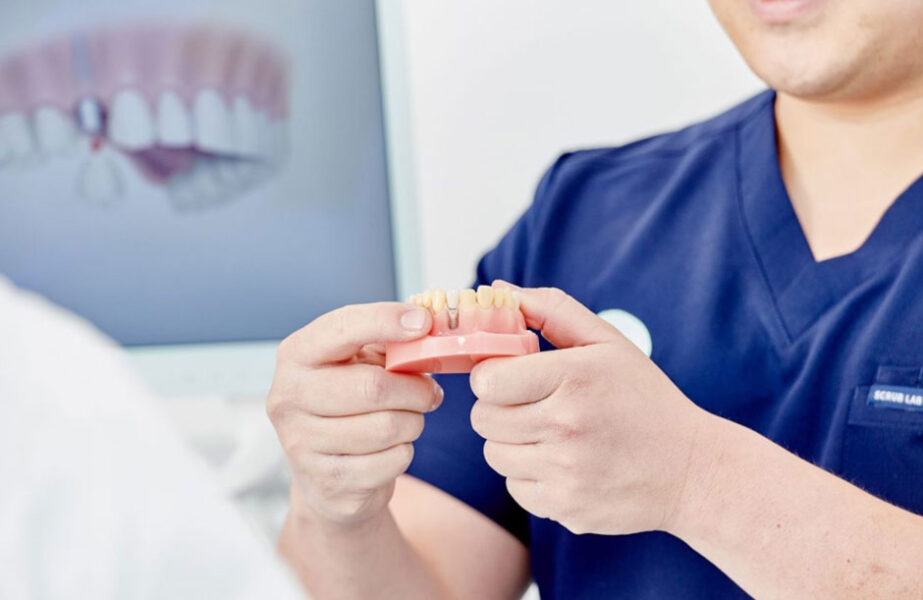Dentures Reimagined: Modern Options for Comfort and Function

With dentures new in the market, you no longer need to compromise on fit or face frequent relines. New technology dentures using digital scans, 3D printing, and AI design deliver precise comfort and lifelike results from the first fitting.
Patients can also choose new false teeth that mimic natural aesthetics and function, reducing the stigma around removable prosthetics.
In this article, you will learn:
- How digital impressions and 3D scanning cut chair time and reduce errors
- Ways CAD/CAM workflows and 3D printing yield a precision fit
- How AI tools optimize bite balance and gum support
- The differences among implant-supported, flexible, and zirconia options
- Which modern materials and features boost comfort and durability
- Tips for selecting the ideal denture based on budget, oral health, and desired function
Next, we explore the key advances in denture technology driving these improvements.
Advancements in Denture Technology
Digital Impressions and 3D Scanning
Traditional impression trays have been replaced by intraoral 3D scanners that record every ridge and curve in minutes. Digital impressions are painless and reduce human error. Clinicians review scans instantly and confirm complete data before design. This approach cuts chair time and speeds workflows for new false teeth technology.
3D Printing for Precision Fit
CAD/CAM workflows use scan data to power high-precision milling or 3D printing. Labs can produce bases, teeth, and trial models in record time. Next-generation resins and ceramics are lighter, stronger, and more stain resistant. Rapid fabrication allows quick chairside adjustments and fewer lab visits.
AI-Powered Design Tools
AI-driven platforms analyze scan data and refine every denture aspect. Deep-learning algorithms optimize occlusal surfaces for balanced bites, while tissue-support maps ensure even gum pressure. Clinicians adjust tooth shape, lip support, and materials with a few clicks, producing a customized denture with comfort and function from day one.
Newest Types of Dentures on the Market
Patients often ask, what are the newest type of dentures on the market? Today’s newest types of dentures include implant-supported, flexible, zirconia, suction-seal, and biofunctional designs. Whether you want new style dentures or the most durable fit, these options suit a range of budgets and oral health needs.
Dentist Valley Stream adds that while all of these are considered modern, advancements in technology are continually improving denture quality. For instance, 3D printing and digital scanning now allow for the creation of ultra-precise, custom-fit dentures with fewer appointments, offering a significant upgrade in both comfort and accuracy.
Implant-Supported Dentures
Implant-supported dentures attach to two to six implants in the jawbone. They eliminate adhesives and improve chewing and speech. By stimulating bone, they help preserve jaw structure and facial contours. With proper care, these dentures can last 15 to 20 years. Patients choose fixed or removable snap-in styles.
Snap-In Dentures
Snap-in dentures use locator attachments that click into place. This design is stable and easy to remove for cleaning. It is a lower-cost implant option suitable for patients with moderate bone loss.
Flexible Dentures
Flexible dentures are made from soft nylon or thermoplastic. They adapt to gum contours and eliminate metal clasps, reducing sore spots. Metal-free partials blend discreetly with tissues. Patients with sensitive gums or irregular ridges often find them more forgiving.
Zirconia and Ultra-Lightweight Options
Zirconia dentures, especially translucent zirconia, are milled from high-strength ceramic. They resist stains, resist chips, and mimic natural translucence. Ultra-lightweight versions reduce bulk and weight. These choices deliver durability and a lifelike look, though they require precise workflows and higher fabrication costs.
Suction and Biofunctional Dentures
Suction-seal dentures use precise base contours to create a vacuum hold against gums, offering stability without paste but requiring healthy ridges. Biofunctional dentures spread chewing forces evenly, reducing jaw strain and improving efficiency. Both designs boost comfort and function, though specialized lab steps can increase cost.
Materials for Enhanced Comfort and Durability
Modern denture materials combine durability with comfort. Advances in base and tooth components reduce weight, improve fit, and extend prosthesis life. This section covers key materials that boost wearability and introduce eco-friendly options.
Acrylic Resins and Polymers
High-grade acrylic resins remain a mainstay for denture bases. These polymers are lightweight and tintable to match gum tissue. Heat-cured formulations offer better fracture resistance and stability. Flexible blends add elasticity to adapt to ridge shapes, reducing pressure points for improved comfort.
Composite Resin Teeth
Composite resin teeth offer high wear resistance and chip reduction compared to porcelain. They maintain shade stability and bond well with acrylic bases. Layered resin structures mimic enamel translucence and texture, giving patients durable, lifelike restorations that resist staining and support function in daily use.
Silicone Liners
Silicone liners serve as soft interfaces between the denture base and oral tissues. They conform to ridge anatomy and cushion mucosal surfaces. Their hardness balances flexibility and resilience, absorbing chewing forces and reducing sore spots. Studies show these liners maintain softness and structure for up to a year before replacement.
Eco-Friendly Biodegradable Options
Eco-friendly denture materials focus on sustainability. Biodegradable polymers such as polylactic acid (PLA) and polycaprolactone (PCL) degrade in controlled conditions. Starch-based polymers and natural fiber-reinforced composites are under evaluation for prototype bases.
Early research shows these materials offer mechanical strength while reducing environmental impact, though clinical adoption is limited.
Innovative Features for Improved Fit and Comfort
Modern dentures include features that address common issues like slippage and soreness. From micro-adjustable attachments to embedded sensors, these innovations help maintain comfort over time. They represent new style dentures and new false teeth technology.
Adjustable Fit Mechanisms
Micro-adjustable systems allow gradual retention tuning as oral tissues remodel, reducing the need for relines. Common options include:
- Threaded abutment screws that incrementally tighten base fit
- Telescopic attachments providing frictional locking between inner and outer frameworks
- Thermoplastic base materials that soften with body heat and conform to gum contours
Anti-Slip and Pressure-Relief Channels
Advanced anti-slip and pressure-relief designs improve stability without excess adhesives. Two key features are:
Enhanced Adhesive Interfaces
Moisture-activated adhesives bond directly to denture surfaces. They improve grip during speaking and chewing without excess paste.
Built-In Pressure Channels
Internal channels redistribute chewing forces across the ridge, preventing focal sore spots for patients with sensitive or underdeveloped ridges.
Smart Sensor Integration
Some prototypes embed small sensors within the base. Piezoelectric or capacitive sensors measure pressure in real time and send feedback via Bluetooth. Clinicians track fit changes and adjust retention before discomfort arises. IoT-enabled systems may eventually automate fit adjustments for personalized comfort.
Choosing Your Ideal Denture Solution
Selecting the right denture involves more than cosmetics. Patients should weigh lifestyle, oral anatomy, and budget. Use this guide to match daily habits with the ideal denture type and digital support tools.
Lifestyle and Budget Considerations
Budget-friendly dentures new include suction-seal and flexible thermoplastic designs. They fit quickly and often cost less upfront.
3D-printed options offer fast turnaround, precise fit, and material efficiency at moderate prices.
Implant-supported and zirconia designs have higher initial costs but can last 15+ years, lowering long-term expenses.
Oral Health and Bone Structure
Evaluate ridge height and bone density with digital X-rays or CBCT scans. Adequate bone support is essential for suction-based dentures. Implant-retained designs help preserve jawbone and facial structure for long-term oral health.
Aesthetic and Functional Goals
Zirconia and biofunctional designs mimic natural translucence and distribute chewing forces evenly. Flexible dentures adapt to gum contours for comfort, though they may wear faster. New style dentures can meet both aesthetic and functional goals.
Telehealth Consultations and Follow-Up
Leverage virtual try-on tools and 3D facial scans for initial fittings. Schedule remote check-ins to assess fit, adjust occlusion, and monitor comfort. A personalized aftercare plan with cleaning routines and in-office or virtual adjustments ensures lasting function.
Conclusion
Modern denture care combines digital precision, innovative materials, and smart features to deliver fit, comfort, and function from day one. By understanding the latest advances, from digital impressions and CAD/CAM workflows to implant-supported, flexible, zirconia, suction-seal, and biofunctional designs, you can choose a solution that aligns with your budget, oral health, and lifestyle.
Key takeaways:
- Digital impressions and CAD/CAM workflows cut chair time and improve accuracy for new technology dentures
- 3D printing and AI tools create personalized fits with balanced bite and gum support
- Implant-supported, flexible, zirconia, suction-seal, and biofunctional dentures each address different needs for stability and comfort
- Advanced materials, including high-grade acrylics, composite resin teeth, silicone liners, and eco-friendly polymers, enhance durability and wearability for dentures new
- Innovative features like adjustable fit mechanisms, pressure-relief channels, and embedded sensors help maintain comfort over time
- Telehealth consultations and remote follow-ups streamline aftercare and ensure lasting function
With these advances, choosing the right denture is no longer a compromise. Talk to your dental professional about which modern option aligns with your goals. Your confident smile starts here with the newest types of dentures.


